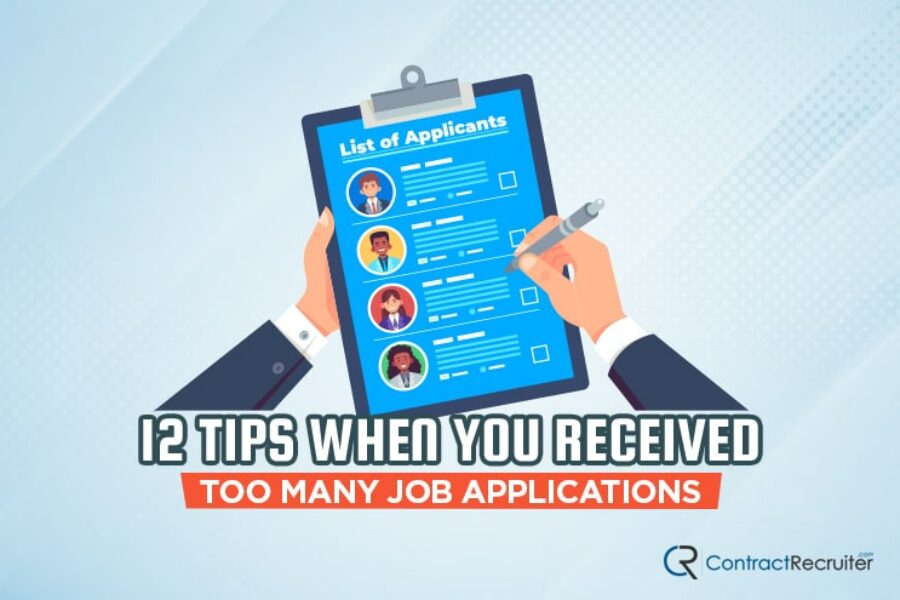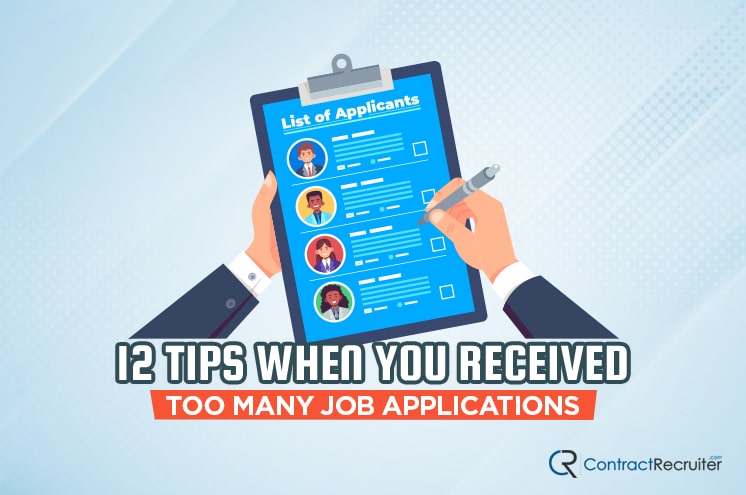Your company has an open role you need to fill. Maybe you have a handful of them, or it’s an ongoing process to fill low-level positions with constant churn. Whatever the reason is, you’ve put up a job posting, and the applications are starting to come in. There’s just one problem.
There are thousands of them.
You have a massive flood of job applications, which means thousands of people to filter through to find the right person for the job.
Even if you’re spending just five minutes per application, that’s only a dozen applications per hour. That’s two solid weeks of 8-hour days doing nothing but looking through these applications.
That’s not sustainable.
Note: Obviously, we’re exaggerating somewhat here. The average job posting receives around 250 applications. Executive positions and upper management will receive fewer, as will highly technical or skilled positions. Front-line and entry-level may receive more, potentially thousands. The point is that you’re always going to be spending a lot of time filtering resumes, so it pays off to find ways to do it more effectively and efficiently.
How can you handle this more efficiently? How can you filter your candidate pool down to something more reasonable without cutting out good candidates?
Here are a dozen tips you can use to streamline the process.
1: Invest in a Good ATS
The first thing you should do is invest in a suitable Applicant Tracking System, or ATS. Note that this is different from using an AI/Machine Learning powered filtering system. We’ll cover that more later.
An ATS is a platform that accumulates all of the information from a job application and presents it in a standardized format. It makes it a lot easier to estimate how well a candidate might fit in based on the information they provide, the results of any assessments you ask them to take, and other factors (like the other items on this list.)
While these systems might not necessarily help you filter applications, using one will help you streamline the process, letting you go through them more quickly and make decisions based on more relevant information. If you’re combing through resumes and application data raw, you run the risk of making judgments based on irrelevant data, which loses you good candidates and can create adverse impact.
What about the filtering itself? What can you do to filter your candidate pool and dig through excess resumes?
2: Set Fast-Track Keywords
You can do two kinds of keyword-based filtering: positive and negative. We’ll discuss both, but let’s start with the positive.
Positive filtering is when you set keywords that would make a given candidate highly desirable. For example, if you’re hiring for a cybersecurity role, you might identify keywords that would indicate a great fit. Things like:
- Mentioning graduating from a top infosec institution.
- Earning high-level certifications in cybersecurity.
- Previous work for highly reputable infosec companies.
If a candidate turns up that checks all the right boxes, you can prioritize looking at their resume and quickly get them in for an interview. With the right set of keywords, you can have a pretty good chance of identifying highly skilled candidates right off the bat.
The trouble with this is two-fold. First, people might lie on their resumes. In an attempt to get past AI filtering, keyword stuffing is unfortunately common. Second, you might miss high-quality candidates who don’t have those resources but would be just as good to hire. And, after all, you can always pay to get a candidate certified if they have the right skills.
3: Set a Red Flag Keyword
The other kind of keyword-based filtering you can do is negative filtering. These are keywords that, if present in a resume, mean that the candidate is almost definitely not what you’re looking for.
These keywords don’t necessarily have to be negative. For example, a candidate whose previous work history includes top-tier organizations might be a poor fit for yours simply due to expecting higher compensation than you can provide. Sure, personal circumstances might mean they’d be willing to accept the role, but they might not enjoy it and might not last. Or, they might make it through the interviews and set a number much higher than you can offer when it comes time to discuss salary.
Many industries also have specific keywords that might indicate that the candidate isn’t appropriate for the role. Mis-using specific terms, graduating from a low-quality educational institution, and other such indications might show that a candidate is worth removing from the pool.
Keyword filtering is always tricky because keywords alone can’t tell the whole story. You always risk eliminating good candidates or fast-tracking poor candidates if you’re using keyword filtering alone. However, other filtering methods can augment these checks and help verify your decision.
4: Look for Minimum Qualifications
Most jobs have minimum qualifications. You might need at least a basic certification, a certain number of years of experience, or particular skills. For example, you don’t want to hire someone to work as a back-end developer if they’ve never looked at PHP or SQL before.
Generally, the idea is to put your minimum qualifications in the job posting. Then, anyone who doesn’t meet them can be removed from the running, both for not meeting them and for not paying attention to the job posting itself.
This is generally most applicable to skilled roles and mid-level roles. Entry-level roles often don’t have tangible minimums, and upper-level roles will have fewer applicants and a greater onus on individual review of each candidate.
5: Look for Spam Submissions
Another check you can run on your candidate pool is if any of the applications are spam. Unfortunately, some organizations will spam fake applications to businesses they dislike as a form of activism. There are also malicious actors who will spam applications just to disrupt businesses.
On a less unsavory level, some low-quality recruiters will “represent” their candidates by putting their applications in pretty much anywhere they can. These recruiters don’t care about skill match, culture match, salary matching, or anything else. They’re in it for the commission. Most of the time, even if you hire someone one of these recruiters represents, they won’t work out.
Often, you can identify these by specific characteristics. Maybe you got a dozen resumes that all look virtually identical. Maybe they were all using the same information as a referrer in a “how did you hear about this job” question, or they have apparent fake data. Regardless of how you identify them, removing them can save you the time you would otherwise spend combing through them.
6: Post a Salary Range Publicly
There’s quite a bit of debate over whether or not to publish salary range information in a job posting. If you’re getting too many job applications, posting a salary range can be a great way to cut down on it. As previously discussed, posting a salary range will weed out candidates who think it’s either too high or too low, cutting back on the number of people who apply.
The caveat here is that your salary should be competitive in the industry and commensurate with the job duties and expectations. Paying well under the market rate generally only works if your target audience is people desperate for a job or when you can spring it on them only after they’ve come too far to back out. Even then, it often doesn’t work.
7: Filter Incomplete Applications
Sometimes, a job application process will send you the application and resume for a candidate even if that candidate has not finished the entire application process. This is often most relevant in cases where an application requests that the candidate fill out forms and additional fields on top of sending in their resume; some will fail to do the rest and hope their resume alone is enough.
A good ATS should filter out any applications that are incomplete or unfinished. There’s no reason to waste your time on a candidate who can’t even finish the application process.
8: Include a Skills Test as Part of the Application Process
Skill assessments as part of the application process can give you a better idea of the talents and knowledge of your candidate. It will also cut back on the number of people who apply because many people won’t want to take the assessment. Luckily, many of those people won’t be qualified or are some of the “spam” submissions mentioned above.
If you include a skills assessment as part of the application process, you can do two things. First, you can ignore the applications of anyone who doesn’t take the assessment. After all, if they can’t complete the application, they shouldn’t be hired.
Second, you can then use the assessment results as part of your review of the candidate. Assessments are graded, after all, so the candidate’s performance on the evaluation can give you good information about their quality as a potential hire.
9: Use a “Follows Instructions” Trap
You may have seen a technique in action over the years, where a job application may have a unique question or field. This question may be something like “Write the word Octopus below” or something equally meaningless.
The entire purpose of the question is to be non-standard. It helps filter out bots and people who aren’t paying attention to what they fill out. It is, essentially, a trap. Anyone who doesn’t fill out that field correctly, no matter how good their application looks, is ignored for being unable to follow instructions.
There are pros and cons to using this method, not the least of which is looking unprofessional and resorting to what is essentially a DIY Captcha to solve a bot problem. Still, it can be a way to filter out some non-candidate applicants to avoid wasting your time.
10: Narrowly Target Your Job Posting
A common mistake that companies make is throwing out job postings everywhere they can to rake in as broad a candidate pool as possible and then filter it down. Unfortunately, this either makes you reliant on an AI ATS system or puts the burden of weeding out hundreds of non-candidates from the pool manually on your HR team.
There are two ways to target a job posting.
The first is to write a relatively narrow post. Deciding what to include as required skills, what culture fit to look for, what certifications or education to require; the less general you can make it, the better.
The second is to consider where you post your job. Sites like Indeed, Monster, CareerBuilder, and Glassdoor are all quite large and can get you a broad candidate pool, but are they worth it over more niche, industry-focused job boards? Probably not.
11: Consider Automated Screening Software
Above, we mentioned the risk of using AI or machine learning to filter resumes. There are two main potential problems.
The first is if the software is unsophisticated and operates primarily on keywords. Keyword-based filters can be baffled by keyword stuffing in resumes, which is common for precisely that reason.
The second is that more machine learning can lead to unexpected decisions. A common example is basing a decision on an otherwise irrelevant part of a resume that the machine identifies as a pattern, like the length of a person’s name or other data. The computer can recognize it even when a human wouldn’t.
AI-based filters can work if they have human oversight. Just don’t become overly reliant on them to make decisions for you.
12: Track Submissions by Platform to Optimize Later
While it won’t help you with your current problem, one good idea is to track where your applicants come from and their overall job performance. When you hire someone, record where they applied from and see if they perform well and how long they stick with your company.
Then, you can identify channels that have never referred a good candidate and stop using them in the future. It’s a great way to cut back on the number of meaningless applications you receive.
Do you or your company have any questions about the possible solutions you can implement if you’ve received too many job applications? Would you like a little more clarification on anything? If so, please feel free to leave a comment down below, and we’ll get a conversation started! We’ll gladly assist you however we possibly can!













